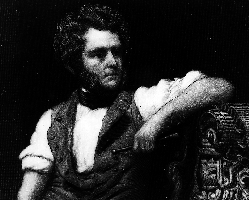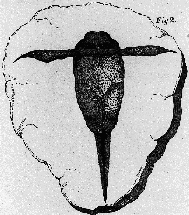Hugh Miller (1802-1856)


Hugh Miller is all but forgotten today, but deserves wider recognition,
both as a working paleontologist and as a great popularizer of science.
Hugh Miller was born on October 10, 1802, in the fishing village of Cromarty
in the north of Scotland. His father was a ship's captain who was lost at
sea when young Hugh was five. The father left his family fairly well-off;
instead of having to go to work at an early age, young Hugh
had time to attend the town's public schools, and to explore the shores and
countryside. At the age of eighteen, he became an apprentice stonemason,
traveling from place to place and job to job.
To the end of his life, he portrayed himself as a simple laboring "man of
the people." Yet he read widely, aspired to a life as a man of letters,
and in 1829 published a book of poetry (which
did not sell well and was generally panned by the critics). Convinced
that prose was a better career option, Miller began writing articles on local
culture and on political issues of the day. He developed a polished, yet
forceful style that would serve him well in the future.
Offered the post of a bank accountant in 1835, Miller had more time to
write -- and more time to devote to studying the rocks of the Cromarty
region, which he had first become interested in as a stonemason.
In 1940 Miller became editor of The Witness, a newspaper devoted
to the cause of the Free Church of Scotland. . . Miller also wrote
many of its articles: commentary, news, criticism, invective, and popular
science all flowed from his busy pen.
 The Cromarty region includes rock beds known as the Old Red Sandstone
(now classified as
Devonian.
The Old Red Sandstone was thought to lack fossils, and there
was much debate as to where they fit into the geological column as
it was then known. Thus, when Miller began finsing beautifully preserved
specimens of unusual armored fish -- such as the Pterichthys seen
at the left -- the specimens attracted a great deal of
attention, and established Miller's reputation in scientific circles.
Miller began sending them to Louis Agassiz, who
was the greatest expert on fossil fish at the time. The two men became
good friends, and shared many of the same religious convictions. Miller's
own book on his finds, The Old Red Sandstone, attracted attention
both for the exquisite fossils it described and for Miller's clear,
powerful writing.
The Cromarty region includes rock beds known as the Old Red Sandstone
(now classified as
Devonian.
The Old Red Sandstone was thought to lack fossils, and there
was much debate as to where they fit into the geological column as
it was then known. Thus, when Miller began finsing beautifully preserved
specimens of unusual armored fish -- such as the Pterichthys seen
at the left -- the specimens attracted a great deal of
attention, and established Miller's reputation in scientific circles.
Miller began sending them to Louis Agassiz, who
was the greatest expert on fossil fish at the time. The two men became
good friends, and shared many of the same religious convictions. Miller's
own book on his finds, The Old Red Sandstone, attracted attention
both for the exquisite fossils it described and for Miller's clear,
powerful writing.
